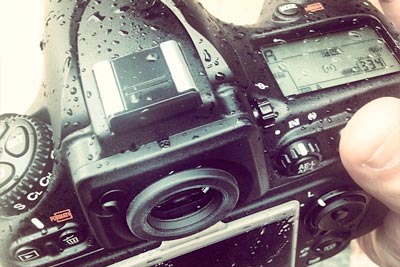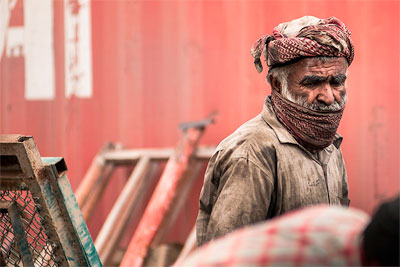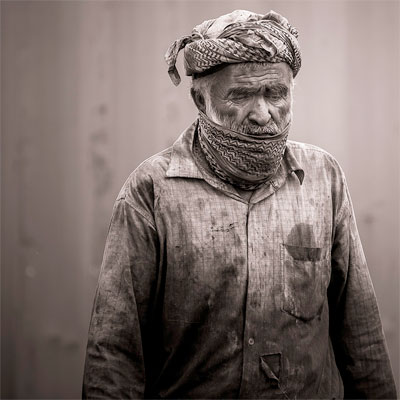
I’ve been carrying the D800 with me all week and I’m loving it. I really haven’t found any major kinks so my first impression has been very positive. I’m going to try and not get into too many technical details but it’s going to be a bit difficult to avoid that since what really differentiates this camera from others is the technical aspects.
Look and Feel
Even though the D800 is a lot more bulkier than regular DSLR’s I still found the size very manageable. I’ve actually been carrying the camera around with me in my small Think Tank 5 bag which I had gotten for my much smaller Panasonic GX1 camera. The camera weight isn’t bad either and feels really solid and comfortable in my hands. The viewfinder is huge compared to my older Nikon D90 but that’s no surprise since the D800 is a full frame camera. What does that mean? If you have a DSLR it’s most likely using a APS-C sensor which is around 23.6 x 15.7mm in size. That sensor is a lot bigger than sensors in point and shoot cameras which are around 7.18 x 5.32mm but it’s still a lot smaller in size compared to a full frame sensor like on the D800 which measures at 36 x 24mm. The larger the sensor the more light and detail it can capture. (more info on sensor sizes)

Customization
The camera has a lot of buttons and majority of them are customizable. I shoot in aperture priority mode so the front rotating dial controls the aperture while I’ve setup the rear sub dial to control the exposure. I have two programmable buttons in the front which I can active without looking and I’ve set one to turn on the virtual horizon inside the viewfinder (shows you if the camera is tilted) while the second button turns on spot metering. One feature I’m currently loving is the Auto-ISO. I’ve previously had cameras that had Auto-ISO but what sets the D800 apart from the others is the fact I can set a minimum shutter speed (for each lens). Once the shutter speed drops below what I’ve set then the camera will increase the ISO until it reaches my minimum shutter speed requirement. I can also set the maximum ISO which I currently have on ISO 6400 (yes it’s that usable!).
The camera has two memory card slots and I can tell the camera to record pictures onto one or video onto the other. I can even tell it to record RAW images onto one, JPG onto the other or even record the same information on both so all my images are backed up. Finally you have three different RAW formats you can save to which is great since the 36MP RAW files can reach 80MB on the highest quality but can drop down to 35MB with very little quality loss if I need.

Features
What’s made this camera really popular is the fact that it’s 36MP. The fact that it’s 36MP was actually a turn off for me since I don’t need 36MP (16MP would be more than enough for my needs). But after shooting with the camera over the weekend I can easily see why 36MP is so great… cropping. When you’re in the moment it’s sometimes difficult to frame the shot the way you want it and that’s what happened with me over the weekend when I was shooting some workers. Because I shot at 36MP, once I got home and started processing the shots I was able to frame and crop into some shots and still have a very large image to work with. Low light shooting is also great with the D800, like I mentioned earlier I have it set on Auto-ISO right now and I’ve set the limit to 6400 because at 6400 the noise is barely noticeable. Actually if I only need the shots for my blog I could shoot with ISO 25,600 and post it here and you wouldn’t be able to see any noise at all.

I really do love this camera. It’s super responsive, there are a ton of buttons which means if I want to change any setting I don’t have to flip through menus, the viewfinder is large and it really just feels great using it. It won’t make me a better photographer but it has reignited my passion for photography. The only negative I have to say about the camera is that you need a powerful computer to process the large RAW files. If you’re paying this much for a camera anyway then you should be willing to invest in your computer. I’m using Lighroom 4 on a 27inch iMAC 3.2Ghz Core 3 with 12GB of RAM and it takes around 5 to 10 seconds to load a photo at full resolution to start developing. I’m now planning to upgrade it to 32GB of RAM to see and if it will help improve things but the best solution will most likely be patience. The camera is currently out of stock all around the world but I pre-ordered mine from Electronic Express and they had it shipped to me within a week. Because of that Electronic Express are now one of my favorite online electronic stores.

32 replies on “First Impression: The Nikon D800”
Does your imac even support 32GB ram?
Yup, had 4 ram slots each can take 8GB
Mmm interesting lol, my motherboard has 6 slots and each can handle 4gb. let’s check online if it supports more.
Lol , an imac supports 36GB o.o .
Let’s check if my motherboard can handle 48GB , since it has 6 slots .
Actually just checked, if I had a Core 5 or 7 I could have installed 32 but since mine is Core 3 I can install 16GB max.
Mark have seen the new Sony digital Slr?
Yes, if you want a DSLR choose between a Nikon and Canon.
It’s not only about the camera, it’s also about the lenses and both Nikon and Canon have a HUGE range to choose from. Sony not so much.
The black and white picture is excellent
the shots can easily made top 10 great pictures of 2012 they are so ridiculously phenomenal. Great job Mark choosing the perfect shots to share
Wow thanks, that was a confidence boost!
Thanks Mark.
When did you purchased it? I checked Electronic Express, and its out of stock .
And how much customs you paid for ?
Yeah it’s out of stock, you need to pre order the camera. I ordered it on the 23rd of march
Excellent Pictures,,,but how much is it ? i think its ridiculously expensive.
$2,999
The old man. There’s something in his eyes that strikes me.
Amazing photo. Looks like a professional took it 🙂 walla!
From confidence boost to confidence dump.
What makes you think Mark’s NOT a professional?
🙂
Canon 5D Mark III is still better overall 😛 great shots!
don’t matter.. its how the person use it
He wasn’t being serious, it’s an inside joke…
lol
Was: $2999.99
Instant Savings: -$0.04
Your Price: $2999.95
You save 4 cents!! lol!
Did you buy any lens with the camera or you had all the lenses you need?
I originally had the following:
Nikon 28mm f/2.8
Nikon 50mm f/1.4
Nikon 80-200mm f/2.8
I sold my 28mm because I wanted to get the 24 f/1.4 but then realized how big (and expensive) that lens was and decided to get the 24mm f/2.8 instead. So now its:
Nikon 24mm f/2.8
Nikon 50mm f/1.4
Nikon 80-200mm f/2.8
Which did you use for these shots?
80-200
D3200…
hi mark
nice cam
i recommend that you change the hard disk of the iMac to SSD (Samsung SSD) not other brand and you will see a big improvment in performance.
good luck and keep posting pics from your Nikon
With each raw file being around 80MB that’s not the best idea in the world considering the sizes of the SSD drives (have u seen how much a 512gb drive costs?)
i agree with you 🙂
It’s the full frame effect, it’s such an amazing transition from other smaller frames. you get much more details and hence Auto Iso, aperture changes and exposures are a lot more noticeable even in small increments. almost identical to the behavior of classic 35mm film.
great shots
I had read this article when you posted it, and came across it again while Googling for something. Now that I have been using the camera for some time, I noticed one error in the article.
“I can set a minimum shutter speed (for each lens)”.
The minimum shutter speed setting is not lens specific but a general one. However, if you set it to Auto, then for CPU based lenses, the camera automatically detects the focal length and adjusts it based on standard formula. (Page 112 in the manual).